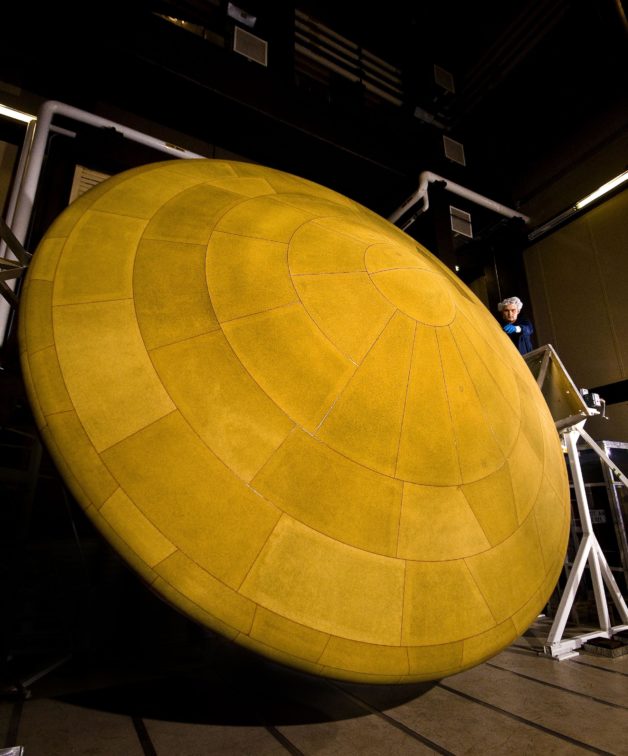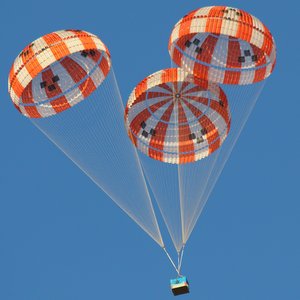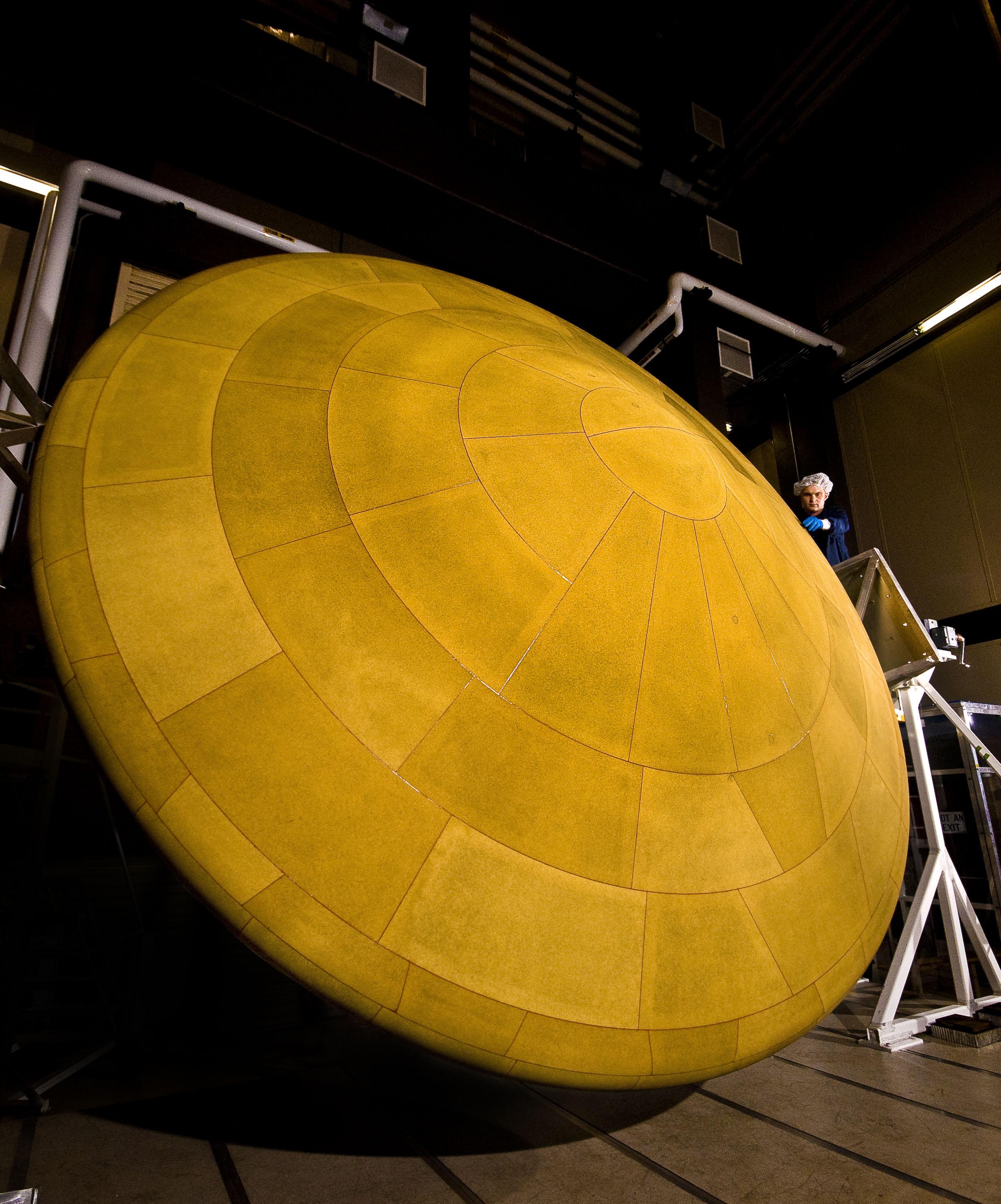
The saucer-like Mars Science Laboratory, which landed the Curiosity rover on MARS, featured the largest heat shield (pictured here)—at 14 feet 9 inches in diameter—to enter a planet’s atmosphere. NASA is now engaging in R&D for even larger heat shields made of flexible, foldable material that can open up like an umbrella to protect spacecraft during atmospheric entry. (Credit: NASA/JPL-Caltech/Lockheed Martin)
Learn More About Berkeley Lab’s X-ray Work with NASA (click on an image below)
Overview

Parachutes

Meteors

The Mars Science Laboratory (MSL) spacecraft that landed the Curiosity rover on Mars endured the hottest, most turbulent atmospheric entry ever attempted in a mission to the Red Planet. The saucer-shaped MSL was protected by a thin, lightweight carbon fiber-based heat-shield material that was a bit denser than balsa wood.
The same material, dubbed PICA (Phenolic Impregnated Carbon Ablator), also protected NASA’s Stardust spacecraft as it returned to Earth after collecting comet and space dust samples in 2006. It is based on a family of materials that was recognized by the space agency as its Invention of the Year in 2007.
SpaceX, a NASA-contracted private company that delivers cargo to the International Space Station, has since adapted the PICA material for its Dragon space capsule.
While traditional heat shields form a rigid structure, NASA Ames Research Center (NASA ARC) in Moffett Field, California, which developed the PICA material, is now developing a new family of flexible heat-shield systems that uses a woven carbon-fiber substrate, or base material. This material’s heat-resistance and structural properties can be fine-tuned by adjusting the weaving techniques.
In addition, the flexible nature of woven materials can accommodate the design of large-profile spacecraft capable of landing heavier payloads, including human crews.
The new flexible heat-shield system, called ADEPT (Adaptive Deployable Entry and Placement Technology), would be stowed inside the spacecraft and deployed like an umbrella prior to atmospheric entry. Supported by an array of sturdy metallic struts, the ADEPT system could also serve to steer the spacecraft during descent.
Unlike the reusable ceramic tiles used on NASA’s space shuttles to survive reentry from low-Earth orbit, the lighter PICA and woven carbon materials are designed for single use, protecting their payload while they slowly burn up during the rigors of atmospheric entry.
NASA’s Adaptable, Deployable Entry Placement Technology (ADEPT) Project will test and demonstrate a large, flexible heat shield that can be stored aboard a spacecraft until needed for atmospheric entry. (Credit: NASA)
That’s why it’s critical to ensure through testing, simulation, and analysis, that heat-shield materials can survive long enough to protect the spacecraft during high-speed entry into a planet’s atmosphere.
To understand performance of the system at the microscopic scale, NASA research scientists are conducting X-ray experiments at Lawrence Berkeley National Laboratory (Berkeley Lab) to track a material’s response to extreme temperatures and pressures.

Click to view animation. This animation, produced from 14 consecutive X-ray tomography scans at Berkeley Lab’s Advanced Light Source, shows how a sample of woven carbon-fiber material degrades over five minutes during heating in an increasingly dense simulated atmosphere. (Credit: NASA, Berkeley Lab)
“We’ve been working on studies of various heat-shield materials for the past three years,” said Harold Barnard, a scientist at Berkeley Lab’s Advanced Light Source (ALS), “and we are trying to develop high-speed X-ray imaging techniques so we can actually capture these heat-shield materials reacting and decomposing in real time.”
During an actual atmospheric entry at Mars, there is substantial heat load on the shielding material, with surface temperatures approaching 4,000 degrees Fahrenheit.

Harold Barnard (from left), Alastair MacDowell and Dula Parkinson are scientists at Berkeley Lab’s Advanced Light Source who are working with NASA to test heat shield and other materials. They use a technique called X-ray micro-tomography to scan objects and produce 3-D renderings of the microstructure of materials. (Credit: Marilyn Chung/Berkeley Lab)
“We are developing methods for recreating those sorts of conditions, and scanning materials in real time as they are experiencing these loads and transitions,” Barnard said. A test platform now in development uses a pneumatic piston to stretch the material, in combination with heat and gas-flow controls, to simulate entry conditions.

A small model of NASA’s ADEPT heat shield, on display at NASA Ames Research Center. (Credit: Marilyn Chung/Berkeley Lab)
Francesco Panerai, a scientist with AMA Inc. at NASA ARC and the lead experimentalist for NASA’s X-ray studies at Berkeley Lab’s ALS, said, “X-rays enable new simulations that we were not able to do before. Before we were using X-rays, we were limited to 2-D images, and we were trying to mimic these with computer simulations. X-ray tomography enables us to digitize the real 3-D microstructure of the material.”
The work at the ALS has already produced some promising results that show how present-day and next-generation heat-shield materials, including woven carbon fibers for flexible heat shields, gradually decompose in simulated atmospheric entry conditions. More experiments are planned to study different weave arrangements and material types.
“You can really see a lot of details” in the ALS images, Panerai said, which were produced using a technique called microtomography. “You can see clusters of fibers, and you can see that the fibers are hollow.” The fibers in the studies are less than one-tenth the width of a human hair.

This image, generated from X-ray micro-tomography scans at Berkeley Lab’s Advanced Light Source, shows the 3-D microscale structure of a carbon-fiber felt material. (Credit: Tim Sandstrom/NASA Ames)
He added, “It’s very complex to reproduce velocity and temperature at the same time in physical experiments. The ALS allows us to reproduce similar conditions to entry—very high temperatures, and we can watch how flow moves inside materials.” The work could benefit future missions to Mars, Saturn, and Venus, among others.
Joseph C. Ferguson, a researcher with Science and Technology Corp. at NASA ARC, led the development of a software tool called PuMA (Porous Materials Analysis) that can extract information about a material’s properties from the ALS X-ray imaging data, including details about how porous a material is, how it conducts heat, and how it decomposes under entry conditions.
All of these characteristics factor into a material’s ability to protect a spacecraft. NASA developers have made this software tool available to other experimenters at the ALS for other applications.
Barnard said the NASA work has pushed ALS researchers to develop faster microtomography imaging methods that capture how materials respond over time to stress.
Click on images to view animations. These four animations show 3-D representations of heat shield materials that are based on X-ray micro-tomography images taken at Berkeley Lab’s ALS, including: a simulation (top left) of gas flow (represented by arrows) in a porous carbon-fiber insulator material; a zoom-in rendering (top right) of a 1-cubic-millimeter sample of a felt substrate used in flexible heat-shield materials; renderings of the untreated (white) and oxidized (bronze) samples (bottom left) of the substrate of NASA’s Phenolic Impregnated Carbon Ablator, or PICA, heat-shield material; and a simulation (bottom right) of the decomposition of carbon fibers during high-temperature exposure to oxygen particles. (Credits: Timothy Sandstrom/NASA Ames; International Journal of Heat and Mass Transfer, Volume 106, March 2017, pages 1318-26, and Volume 108, Part A, May 2017, pages 801-11; and Carbon, Volume 96, January 2016, pages 57-65)
“We have been able to push the imaging speed down to between 2.5 to 3 seconds per scan,” Barnard said. “Normally these scans can take up to 10 minutes. It has been good for us to work on this project. We want better instrumentation and analysis techniques for the experiments here, and we are pushing our instrumentation boundaries while helping NASA to develop heat shields.”
Dula Parkinson, a research scientist who works with Barnard at the ALS on microtomography experiments, said the faster imaging speeds, which can produce about 2,000 frames per second, are generating a high volume of data.
“The capabilities of our detectors and other instruments over the past five years have improved orders of magnitude,” Parkinson said. “It has increased our needs for data management and computing power.”
The ALS draws on resources from Berkeley Lab’s Center for Advanced Mathematics for Energy Research Applications (CAMERA), which assists with image processing and algorithms for visualizing the X-ray data, and also from Berkeley Lab’s National Energy Research Scientific Computing Center (NERSC).
NASA ARC researchers also tap into ALS-produced data via the Energy Sciences Network (ESnet), a high-bandwidth data network managed by Berkeley Lab that connects research facilities and supercomputer centers. NASA scientists use NASA ARC’s Pleiades, one of the world’s most powerful supercomputers, to perform analysis and simulations on data generated at the ALS.

Francesco Panerai, a researcher at NASA Ames Research Center, describes the components in a prototype flexible heat shield that uses woven carbon fibers. (Credit: Marilyn Chung/Berkeley Lab)
“Supercomputing is very important in this effort,” Panerai said. “One of the areas we will explore is to try to predict the properties of a virtual material” based on what is learned from X-ray experiments and computer modeling of existing materials.
“We would like to know the material’s response before we create it,” Panerai said. “We think this could help in materials design.”
Learn more about the research partnership between NASA and Berkeley Lab in these articles:
- When Rocket Science Meets X-ray Science: Berkeley Lab and NASA collaborate in X-ray experiments to ensure safety, reliability of spacecraft systems.
- A New Paradigm in Parachute Design: X-ray studies showing the microscopic structure of spacecraft parachute fabric can fill in key details about how they perform under extreme conditions.
- Getting to Know Meteors Better: Experiments at Berkeley Lab may help assess risks posed by falling Space rocks.
Berkeley Lab’s ALS and NERSC are DOE Office of Science User Facilities.
# # #
Lawrence Berkeley National Laboratory addresses the world’s most urgent scientific challenges by advancing sustainable energy, protecting human health, creating new materials, and revealing the origin and fate of the universe. Founded in 1931, Berkeley Lab’s scientific expertise has been recognized with 13 Nobel Prizes. The University of California manages Berkeley Lab for the U.S. Department of Energy’s Office of Science. For more, visit www.lbl.gov.
DOE’s Office of Science is the single largest supporter of basic research in the physical sciences in the United States, and is working to address some of the most pressing challenges of our time. For more information, please visit science.energy.gov.




